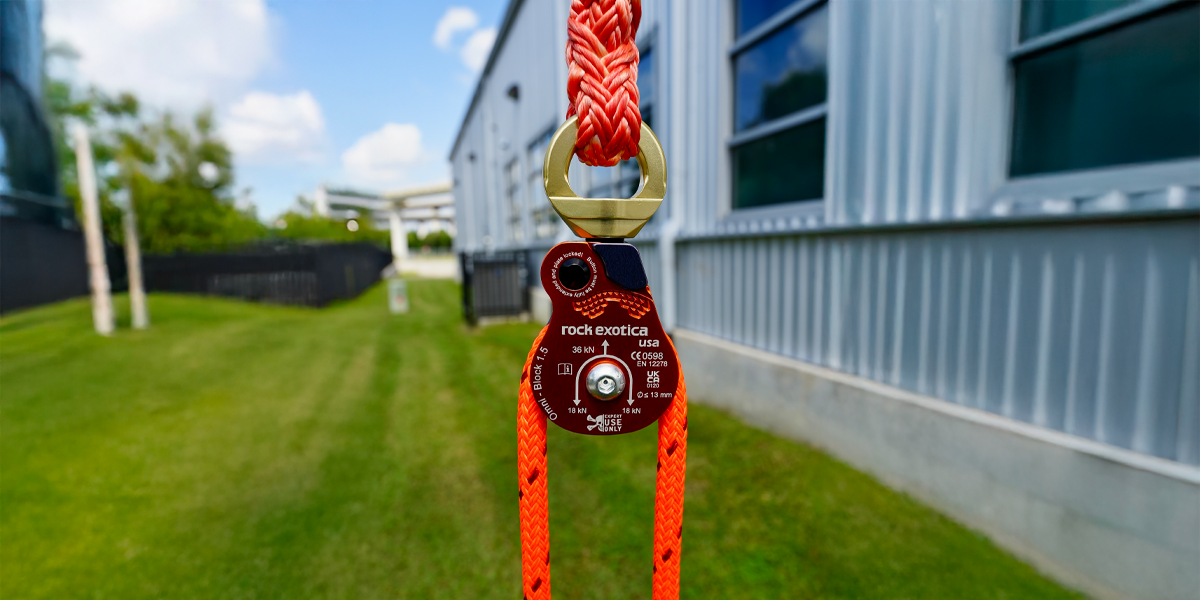Tree pruning, directional cutting, and controlled limb lowering are not only about cutting techniques but also closely tied to the proper use of tree rigging equipment. Systems used to guide falling logs safely from height directly affect both job-site safety and operational efficiency. Proper setup and the right choice of rigging gear are critical to ensure control and productivity.
How to Set Up Tree Rigging Equipment Properly
The main goal in setting up a tree rigging system is to manage the load effectively in terms of friction, angles, and force distribution. For that:
-
When selecting the main anchor point, choose a structurally sound part of the tree.
-
Blocks or pulleys like the CMI Mini Arborist Block should be secured using reliable ring slings.
-
Friction devices such as portawraps or bollards must be correctly placed along the descent path.
Before setup begins, slope, ground conditions, and drop zones should be evaluated. Such pre-assessments are essential for both efficiency and site safety. Neglecting proper planning can result in serious damage during rigging operations.
How to Combine Tree Rigging Block and Slings for Maximum Efficiency
Using rigging blocks with slings offers maximum control, especially for heavy limbs. For instance:
-
Integrated systems like the Rock Exotica Omni Block Sling allow the block and sling to function as one unit.
-
Multi-ring options like the 5/8 LPX Pluto Multi Ring Sling help distribute loads flexibly,
-
Proper pulley angles reduce physical strain and improve control.
The length of the sling is just as important as the type. Adjustable slings like whoopies offer flexibility around branches of varying diameters.
What Tree Rigging Equipment Should Be Used?
Rigging gear is tailored for specific tasks. Essentials include:
-
Bull Rope: For carrying and lowering loads. Example: Arbo Space LDB Bull Rope
-
Slings: Used to attach blocks or pulleys—available in ring, loopie, or whoopie formats.
-
Portawraps/Bollards: Provide controlled descent.
-
Blocks and Pulleys: Reduce friction and improve direction change efficiency.
Supporting tools like carabiners and rigging plates ensure structural integrity. Steel carabiners are generally more suitable for high-stress loads than aluminum ones.
What Should You Consider When Choosing Tree Rigging Gear?
-
Load capacity: Always consider the Minimum Breaking Strength (MBS) and Working Load Limit (WLL). These determine the safe load range and prevent failure during operation.
-
Material and coating: Polyester, Dyneema, and Tenex offer different benefits. Your choice affects flexibility, abrasion resistance, and weather durability.
-
Usage frequency: Choose more durable gear for commercial or repeated use. Heavily used equipment must meet higher performance thresholds.
-
Standard compliance: Opt for gear with ANSI or EN certifications. These standards verify independent safety testing and structural reliability.
Also consider systems with replaceable parts (e.g., replaceable rope segments on portawraps), as they offer easier maintenance and longer service life.
How to Select the Right Tree Rigging Rope
When choosing a tree rigging rope, consider:
-
Load weight,
-
Drop distance,
-
Rope stretch characteristics,
-
Friction device compatibility
For instance, the Shock DB 5/8 Rigging Line offers shock absorption to handle sudden load impact. Product comparisons like Samson Stable Braid vs Arbo Space LDB on the Arbo Space blog provide deeper insights. Polyester blends may be preferred for smoother control and better abrasion resistance, especially when used with friction devices.
How to Properly Use Tree Rigging Pulleys
Tree rigging pulleys are at the heart of the load management system. They:
-
Change the direction of the load,
-
Minimize friction,
-
Enable smoother, safer descent speeds
The pulley must match rope diameter, expected load, and locking design. The ISC RP200 Rigging Block is ideal for heavy-duty operations. Some arborists prefer swivel pulleys for greater movement flexibility and less rope twist. An example would be the Rock Exotica Swivel Block.
Explore Certified Tree Rigging Gear at Arbospace
Access all the certified tree rigging gear you need for complex jobs in Arbospace's Tree Rigging Collection. The collection includes gear tested for professional use and compliant with ANSI and EN standards. Whether choosing bull ropes or setting up block-sling combos, there are options for every budget and performance need.
Selecting the right products and combining them effectively enhances both safety and workflow efficiency. For deeper comparisons, explore other Arbo Space blog posts like Rigging Block and Pulley Tips for Arborists or Shock Absorbing Rigging Ropes: Samson vs Arbo Space. Whether you're a seasoned arborist or just getting started, this guide offers actionable insights for the field.

